Identifying Spatial Relationships between Built Heritage Resources and Short-Term Rentals before the Covid-19 Pandemic: Exploratory Perspectives on Sustainability Issues
Abstract
1. Introduction
2. Background
2.1. Short-Term Rentals and Historic Centres
2.2. The City of Turin (Italy) As a Case-Study
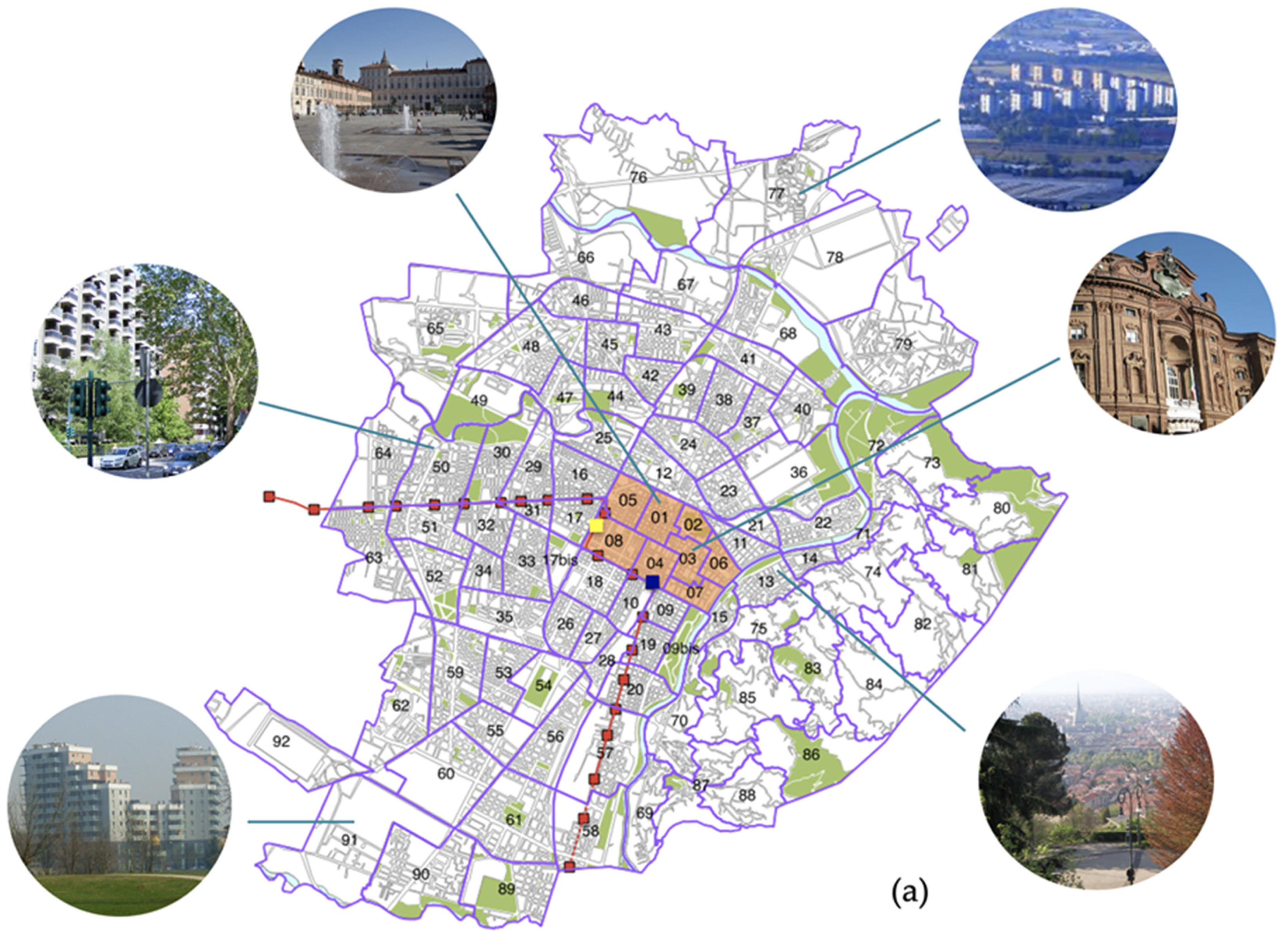
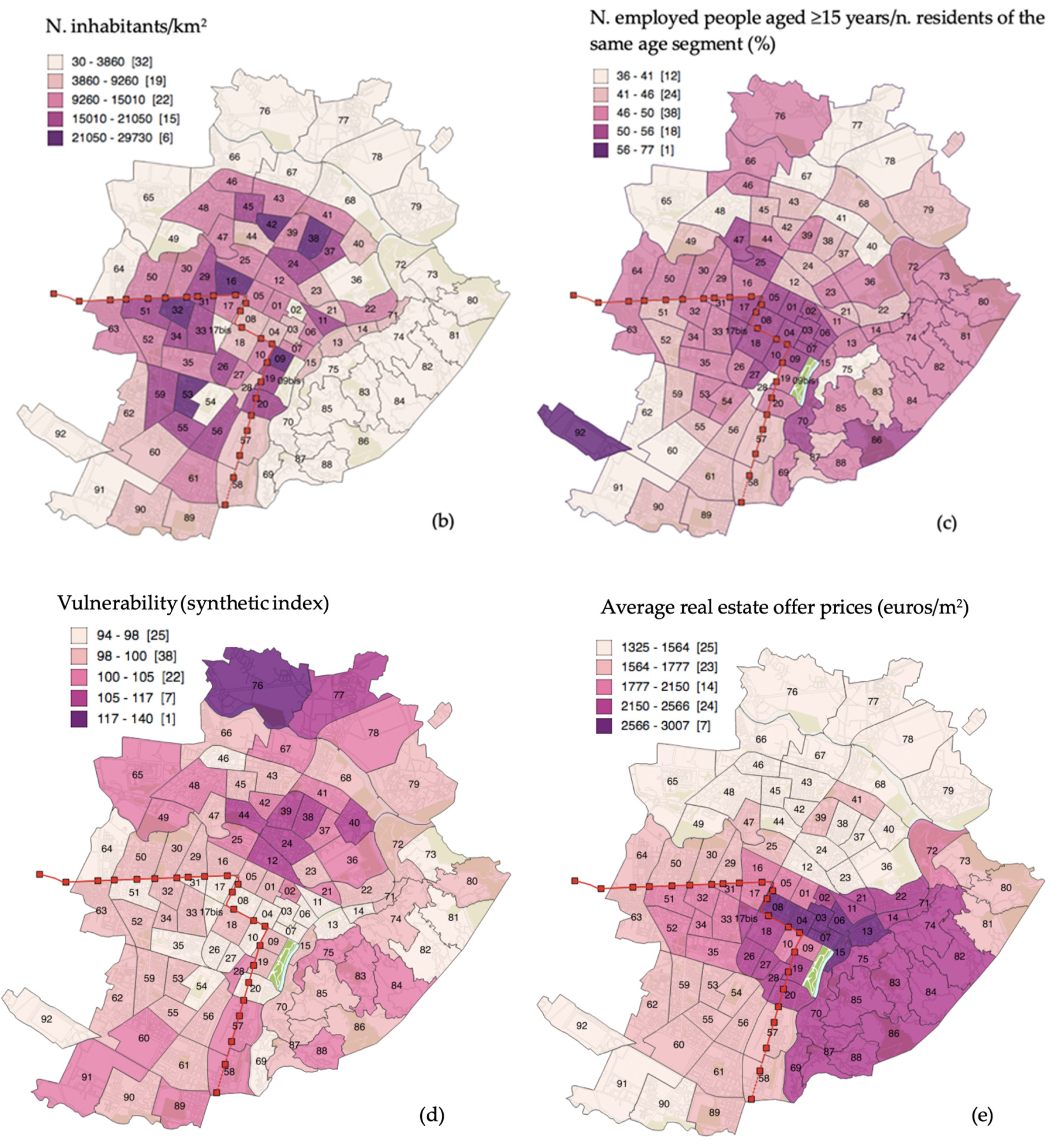
3. Materials and Methods
3.1. Data Sources and Data Processing
3.2. Spatial Analysis
4. Results and Discussion
4.1. Short-Term Rentals Offer and Spatial Distribution
4.2. Built Heritage Resources
4.3. Spatial Statistics
5. Conclusions and Steps for Future Research
Author Contributions
Funding
Acknowledgments
Conflicts of Interest
Appendix A
| SZ | Name | SZ | Name | SZ | Name |
|---|---|---|---|---|---|
| 01 | Municipio | 31 | Boringhieri | 63 | Venchi Unica |
| 02 | Palazzo Reale | 32 | Borgata Cenisia | 64 | Aeronautica-Pellerina |
| 03 | Palazzo Carignano- Vecchio Ospedale (Borgo Nuovo) | 33 | Borgo San Paolo | 65 | Vallette-Saffarona-Villa Cristina |
| 04 | Piazza San Carlo-Piazza Carlo Felice | 34 | Borgata Monginevro | 66 | Stradale di Lanzo |
| 05 | Piazza Statuto | 35 | Polo Nord | 67 | Basse di Stura-Nuovo Poligono |
| 06 | Piazza Vittorio Veneto | 36 | Cimitero Generale- Scalo Vanchiglia | 68 | Barriera di Stura-Istituto Rebaudengo |
| 07 | Corso Cairoli-Piazza Bodoni (Borgo Nuovo) | 37 | Borgata Maddalene | 69 | Fioccardo-Alberoni |
| 08 | Comandi Militari- Stazione Porta Susa | 38 | Borgata Monterosa | 70 | Pilonetto |
| 09 | Piazza Madama Cristina (Borgo San Salvario) | 39 | Borgata Montebianco | 71 | Madonna del Pilone |
| 9bis | Parco del Valentino | 40 | Regio Parco | 72 | Borgata Sassi-Meisino |
| 10 | Borgo San Secondo-Stazione Porta Nuova | 41 | Nuova Barriera di Milano | 73 | Strada di Soperga |
| 11 | Borgo Vanchiglia | 42 | Borgata Vittoria | 74 | Barriera di Chieri-Valpiana |
| 12 | Borgo Dora-Valdocco | 43 | La Fossata | 75 | Villa della Regina-Val Salice |
| 13 | Borgo Po- Parco Michelotti | 44 | Officine Savigliano- Acciaierie Fiat | 76 | Villaretto |
| 14 | Motovelodromo | 45 | Madonna di Campagna | 77 | Falchera |
| 15 | Borgo Crimea- Monte dei Cappuccini | 46 | Nuova barriera di Lanzo | 78 | Villaggio Snia |
| 16 | Borgo San Donato | 47 | Borgata Ceronda | 79 | Barca-Bertolla-Abbadia di Stura |
| 17 | Mercato del Bestiame- Aiuola Martini | 48 | Borgata Lucento | 80 | Soperga |
| 17bis | Carceri-Officine Ferroviarie | 49 | Parco Mario Carrara-Istituto Bonafous | 81 | Mongreno |
| 18 | Vecchia Piazza d’Armi | 50 | Borgata Parella-Lionetto | 82 | Reaglie-Forni e Goffi |
| 19 | Piazza Nizza (Borgo San Salvario) | 51 | Pozzo Strada | 83 | Santa Margherita |
| 20 | Corso Dante-Ponte Isabella | 52 | Parco Francesco Ruffini-Borgata Lesna | 84 | Strada di Pecetto-Eremo |
| 21 | Gasometro | 53 | Santa Rita da Cascia | 85 | San Vito–Val Salice |
| 22 | Vanchiglietta | 54 | Stadio Comunale | 86 | Parco della Rimembranza |
| 23 | Borgo Rossini | 55 | Ospizio di Carità | 87 | Cavoretto-Val Pattonera |
| 24 | Borgata Aurora | 56 | Mercato Ortofrutticolo | 88 | Tetti Gramaglia-Strada dei Ronchi |
| 25 | Piazzale Umbria-Scalo Valdocco | 57 | Molinette-Vecchia Fiat-Stazione | 89 | Ex Aeroporto di Mirafiori |
| 26 | Crocetta | 58 | Millefonti-Nuova Barriera di Nizza | 90 | Mirafiori-Città Giardino |
| 27 | Ospedale Mauriziano | 59 | Barriera di Orbassano | 91 | Drosso-Fornaci |
| 28 | Borgo San Giorgio | 60 | Nuova Fiat | 92 | Tre Tetti-Bellezia |
| 29 | Borgata Campidoglio-Martinetto | 61 | Lingotto-Ex Ippodromo | ||
| 30 | La Tesoriera-Martinetto | 62 | Sanatorio-Gerbido |
References
- Cerreta, M.; Inglese, P.; Malangone, V.; Panaro, S. Complex values-based approach for multidimensional evaluation of landscape. In Proceedings of the International Conference on Computational Science and Its Applications, Guimarães, Portugal, 30 June–3 July 2014; Springer: Cham, Switzerland, 2014; pp. 382–397. [Google Scholar]
- Snowball, J.D. The economic, social and cultural impact of cultural heritage: Methods and examples. In Handbook on the Economics of Cultural Heritage; Rizzo, I., Mignosa, A., Eds.; Edward Elgar Publishing: Cheltenham, UK; Northampton, MA, USA, 2013; pp. 438–455. [Google Scholar]
- Throsby, C.D. Economics and Culture; Reprint; Cambridge University Press: Cambridge, UK, 2001; ISBN 0-521-58639-9. [Google Scholar]
- Coscia, C.; Russo, V. The Valorization of Economic Assets and Social Capacities of the Historic Farmhouse System in Peri-Urban Allocation: A Sample of Application of the Corporate Social Responsible (CSR) Approach. In Smart and Sustainable Planning for Cities and Regions; Bisello, A., Vettorato, D., Laconte, P., Costa, S., Eds.; Springer International Publishing: Cham, Switzerland, 2018; pp. 615–634. ISBN 978-3-319-75773-5. [Google Scholar]
- Coscia, C.; Lazzari, G.; Rubino, I. Values, Memory, and the Role of Exploratory Methods for Policy-Design Processes and the Sustainable Redevelopment of Waterfront Contexts: The Case of Officine Piaggio (Italy). Sustainability 2018, 10, 2989. [Google Scholar] [CrossRef]
- Coscia, C.; Fregonara, E.; Rolando, D. Project management, briefing and territorial planning. The case of military properties disposal. TERRITORIO 2015, 135–144. [Google Scholar] [CrossRef]
- Cinieri, V.; Zamperini, E. Lifecycle oriented approach for sustainable preservation of historical built heritage. In Online Proceedings of the international conference Built Heritage 2013—Monitoring Conservation Management; Boriani, M., Gabaglio, R., Gulotta, D., Eds.; Politecnico di Milano: Milan, Italy, 2013; pp. 465–471. [Google Scholar]
- Fusco Girard, L.; Gravagnuolo, A. Circular economy and cultural heritage/landscape regeneration. Circular business, financing and governance models for a competitive Europe. Bdc. Boll. Del Cent. Calza Bini 2017, 17, 35–52. [Google Scholar]
- Foster, G. Circular economy strategies for adaptive reuse of cultural heritage buildings to reduce environmental impacts. Resour. Conserv. Recycl. 2020, 152, 104507. [Google Scholar] [CrossRef]
- Morkunaite, Z.; Podvezko, V.; Zavadskas, E.K.; Bausys, R. Contractor selection for renovation of cultural heritage buildings by PROMETHEE method. Arch. Civil. Mech. Eng. 2019, 19, 1056–1071. [Google Scholar] [CrossRef]
- Morkunaite, Z.; Podvezko, V. Criteria Evaluation for Contractor Selection in Cultural Heritage Projects Using Multiple Criteria Approach. In Proceedings of the 17th International Colloquium on Sustainable Decisions in Built Environment, Vilnius, Lithuania, 15 May 2019. [Google Scholar]
- Fregonara, E.; Lo Verso, V.R.M.; Lisa, M.; Callegari, G. Retrofit Scenarios and Economic Sustainability. A Case-study in the Italian Context. Energy Procedia 2017, 111, 245–255. [Google Scholar] [CrossRef]
- Becchio, C.; Ferrando, D.G.; Fregonara, E.; Milani, N.; Quercia, C.; Serra, V. The cost-optimal methodology for the energy retrofit of an ex-industrial building located in Northern Italy. Energy Build. 2016, 127, 590–602. [Google Scholar] [CrossRef]
- Rosato, P.; Rotaris, L.; Breil, M.; Zanatta, V. Do We care about Built Cultural Heritage? The Empirical Evidence Based on the Veneto House Market; Fondazione Eni Enrico Mattei: Milan, Italy, 2008. [Google Scholar]
- Manganelli, B. Valutazioni economico-estimative nella valorizzazione di edifici storico-architettonici. Aestimum 2007, 51, 21–42. [Google Scholar]
- Ashworth, G.; Page, S.J. Urban tourism research: Recent progress and current paradoxes. Tour. Manag. 2011, 32, 1–15. [Google Scholar] [CrossRef]
- De Caro, S. Sviluppo del turismo e protezione del patrimonio culturale: Una sfida per il Ventunesimo secolo. In Città Storiche e Turismo Culturale: Città D’arte o Città di Cultura? Marketing Urbano o Turismo Culturale; Colletta, T., Ed.; Giannini: Napoli, Italy, 2013; ISBN 978-88-7431-662-5. [Google Scholar]
- Fusco Girard, L. L’economia della conservazione nel marketing urbano ed il turismo sostenibile nelle città storiche. In Città Storiche e Turismo Culturale: Città D’arte o Città di Cultura? Marketing Urbano o Turismo Culturale; Colletta, T., Ed.; Giannini: Napoli, Italy, 2013; ISBN 978-88-7431-662-5. [Google Scholar]
- Colletta, T. Città storiche e turismo culturale. L’innovazione tecnologica del sapere urbano e l’informazione-promozione turistico-culturale. In Città Storiche e Turismo Culturale: Città D’arte o Città di Cultura? Marketing Urbano o Turismo Culturale; Colletta, T., Ed.; Giannini: Napoli, Italy, 2013; ISBN 978-88-7431-662-5. [Google Scholar]
- Akin, N. Istanbul: Patrimoine Mondial et ses Problèmes de réservation dans le cadre du Tourisme Culturel. In Città Storiche e Turismo Culturale: Città D’arte o Città di Cultura? Marketing Urbano o Turismo Culturale; Colletta, T., Ed.; Giannini: Napoli, Italy, 2013; ISBN 978-88-7431-662-5. [Google Scholar]
- Glaeser, E.L.; Kolko, J.; Saiz, A. Consumer City. J. Econ. Geogr. 2001, 1, 27–50. [Google Scholar] [CrossRef]
- Koster, H.R.A.; Rouwendal, J. Historic Amenities and Housing Externalities: Evidence from the Netherlands; Tinbergen Institute: Amsterdam, The Netherlands, 2015. [Google Scholar]
- Koster, H.R.A.; Van Ommeren, J.; Rietveld, P. Historic Amenities, Income and Sorting of Households; Vrije Universiteit Amsterdam—Spatial Econometrics research Centre: Amsterdam, The Netherlands, 2013. [Google Scholar]
- Rypkema, D. Heritage Conservation and Property Values. In The Economics of Uniqueness: Investing in Historic City Cores and Cultural Heritage Assets for Sustainable Development; Licciardi, G., Amirtahmasebi, R., World Bank, Eds.; The urban development series; The World Bank: Washington, DC, USA, 2012; pp. 107–142. ISBN 978-0-8213-9650-6. [Google Scholar]
- Nijkamp, P. Economic Valuation of Cultural Heritage. In The Economics of Uniqueness: Investing in Historic City Cores and Cultural Heritage Assets for Sustainable Development; Licciardi, G., Amirtahmasebi, R., World Bank, Eds.; The World Bank: Washington, DC, USA, 2012; pp. 75–106. [Google Scholar]
- Yang, Y.; Luo, H.; Law, R. Theoretical, empirical, and operational models in hotel location research. Int. J. Hosp. Manag. 2014, 36, 209–220. [Google Scholar] [CrossRef]
- Ashworth, G.J.; Tunbridge, J.E. The tourist-historic city: Retrospect and prospect of managing the heritage city. In Advances in Tourism Research Series, 1st ed.; Pergamon: Amsterdam, NY, USA, 2000; ISBN 0-08-043675-7. [Google Scholar]
- Guttentag, D. Airbnb: Disruptive innovation and the rise of an informal tourism accommodation sector. Curr. Issues Tour. 2015, 18, 1192–1217. [Google Scholar] [CrossRef]
- Varma, A.; Jukic, N.; Pestek, A.; Shultz, C.J.; Nestorov, S. Airbnb: Exciting innovation or passing fad? Tour. Manag. Perspect. 2016, 20, 228–237. [Google Scholar] [CrossRef]
- Boztas, S. Buyer be-ware: Amsterdam seeks to ban buy-to-let on newbuild homes. The Guardian. 2019. Available online: https://www.theguardian.com/world/2019/mar/18/buyer-beware-amsterdam-seeks-to-ban-buy-to-let-on-newbuild-homes (accessed on 1 February 2020).
- Garcia-Ayllon, S. Urban Transformations as an Indicator of Unsustainability in the P2P Mass Tourism Phenomenon: The Airbnb Case in Spain through Three Case Studies. Sustainability 2018, 10, 2933. [Google Scholar] [CrossRef]
- Coldwell, W. First Venice and Barcelona: Now anti-tourism marches spread across Europe. The Guardian. 2017. Available online: https://www.theguardian.com/travel/2017/aug/10/anti-tourism-marches-spread-across-europe-venice-barcelona (accessed on 10 January 2020).
- Edwards, C. Venice wants to ban new hotels from opening in its historic centre. The Local. 2017. Available online: https://www.thelocal.it/20170602/venice-ban-new-hotels-bandb-from-opening-in-historic-centre-travel-tourism (accessed on 10 January 2020).
- Gutiérrez, J.; García-Palomares, J.C.; Romanillos, G.; Salas-Olmedo, M.H. The eruption of Airbnb in tourist cities: Comparing spatial patterns of hotels and peer-to-peer accommodation in Barcelona. Tour. Manag. 2017, 62, 278–291. [Google Scholar] [CrossRef]
- Picascia, S.; Romano, A.; Teobaldi, M. The airification of cities: Making sense of the impact of peer to peer short term letting on urban functions and economy. In Proceedings of the Annual Congress of the Association of European Schools of Planning, Lisbon, Portugal, 11–14 July 2017. [Google Scholar]
- Quattrone, G.; Proserpio, D.; Quercia, D.; Capra, L.; Musolesi, M. Who Benefits from the “Sharing” Economy of Airbnb; ACM Press: New York, NY, USA, 2016; pp. 1385–1394. [Google Scholar]
- Ven der Zee, R. The “Airbnb effect”: Is it real, and what is it doing to a city like Amsterdam? The Guardian. 2016. Available online: https://www.theguardian.com/cities/2016/oct/06/the-airbnb-effect-amsterdam-fairbnb-property-prices-communities (accessed on 15 January 2020).
- Cocola-Gant, A.; Gago, A. Airbnb, buy-to-let investment and tourism-driven displacement: A case study in Lisbon. Environ. Plan. A Econ. Space 2019. [Google Scholar] [CrossRef]
- Anselin, L. The Moran Scatterplot as an ESDA Tool to Assess Local Instability in Spatial Association. In Spatial Analytical Perspectives on GIS; Fischer, M., Scholten, H., Unwin, D., Eds.; Taylor & Francis: London, UK, 1996; pp. 111–125. [Google Scholar]
- Vanolo, A. The image of the creative city: Some reflections on urban branding in Turin. Cities 2008, 25, 370–382. [Google Scholar] [CrossRef]
- Vanolo, A. The image of the creative city, eight years later: Turin, urban branding and the economic crisis taboo. Cities 2015, 46, 1–7. [Google Scholar] [CrossRef]
- Vanolo, A. The Fordist city and the creative city: Evolution and resilience in Turin, Italy. CityCult. Soc. 2015, 6, 69–74. [Google Scholar] [CrossRef]
- Longley, P.A.; Goodchild, M.F.; Maguire, D.J.; Rhind, D.W. (Eds.) Geographic Information Science & Systems, 4th ed.; Wiley: New York, NY, USA, 2015. [Google Scholar]
- Ke, Q. Sharing Means Renting? An Entire-marketplace Analysis of Airbnb. In Proceedings of the 2017 ACM on Web Science Conference—WebSci ’17, Troy, NY, USA, 25–28 June 2017; ACM Press: Troy, NY, USA, 2017; pp. 131–139. [Google Scholar]
- Airbnb. Fast Facts. 2020. Available online: https://news.airbnb.com/fast-facts/ (accessed on 10 January 2020).
- Sdino, L.; Magoni, S. The Sharing Economy and Real Estate Market: The Phenomenon of Shared Houses. In Smart and Sustainable Planning for Cities and Regions; Bisello, A., Vettorato, D., Laconte, P., Costa, S., Eds.; Springer International Publishing: Cham, Switzerland, 2018; pp. 241–251. [Google Scholar]
- Wachsmuth, D.; Weisler, A. Airbnb and the rent gap: Gentrification through the sharing economy. Environ. Plan. A 2018, 50, 1147–1170. [Google Scholar] [CrossRef]
- Rubino, I. Short-term rentals and transformations in urban areas: The case of Turin (Italy). Territ. Ital. 2018, 1, 91–109. [Google Scholar]
- Mermet, A.C. Airbnb and Tourism Gentrification: Critical Insights from the Exploratory Analysis of the ‘Airbnb Syndrome’ in Reykjavík. In Tourism and Gentrification in Contemporary Cities; Gravari-Barbas, M., Guinand, S., Eds.; Routledge: London, UK, 2017; pp. 52–74. [Google Scholar]
- Blal, I.; Singal, M.; Templin, J. Airbnb’s effect on hotel sales growth. Int. J. Hosp. Manag. 2018, 73, 85–92. [Google Scholar] [CrossRef]
- Chen, Y.; Xie, K. Consumer valuation of Airbnb listings: A hedonic pricing approach. Int. J. Contemp. Hosp. Manag. 2017, 29, 2405–2424. [Google Scholar] [CrossRef]
- Gurran, N.; Phibbs, P. When Tourists Move In: How Should Urban Planners Respond to Airbnb? J. Am. Plan. Assoc. 2017, 83, 80–92. [Google Scholar] [CrossRef]
- Schäfer, P.; Braun, N. Misuse through short-term rentals on the Berlin housing market. Int. J. Hous. Mark. Anal. 2016, 9, 287–311. [Google Scholar] [CrossRef]
- Horn, K.; Merante, M. Is home sharing driving up rents? Evidence from Airbnb in Boston. J. Hous. Econ. 2017, 38, 14–24. [Google Scholar] [CrossRef]
- del Romero Renau, L. Touristification, Sharing Economies and the New Geography of Urban Conflicts. Urban. Sci. 2018, 2, 104. [Google Scholar] [CrossRef]
- Guttentag, D. Airbnb: Why Tourists Choose It and How They Use It. Available online: https://www.dg-research.com/Papers/Summary%20doc%20-%20Airbnb.pdf (accessed on 2 June 2020).
- Mody, M.; Suess, C.; Dogru, T. Comparing apples and oranges? Examining the impacts of Airbnb on hotel performance in Boston. Boston Hosp. Rev. 2017, 5, 1–15. [Google Scholar]
- Cheng, M.; Jin, X. What do Airbnb users care about? An analysis of online review comments. Int. J. Hosp. Manag. 2019, 76, 58–70. [Google Scholar] [CrossRef]
- Guo, Y.; Wang, Y.; Wang, C. Exploring the Salient Attributes of Short-Term Rental Experience: An Analysis of Online Reviews from Chinese Guests. Sustainability 2019, 11, 4290. [Google Scholar] [CrossRef]
- Atelier Parisien d’Urbanisme. Comparison of Regulatory Action Taken in Barcelona, New York and Paris. In Short-Term Rentals: An Analysis of Metropolitan Public Responses; Atelier Parisien d’Urbanisme: Paris, France, 2018. [Google Scholar]
- Prayag, G.; Ozanne, L.K. A systematic review of peer-to-peer (P2P) accommodation sharing research from 2010 to 2016: Progress and prospects from the multi-level perspective. J. Hosp. Mark. Manag. 2018, 27, 649–678. [Google Scholar] [CrossRef]
- Arbel, A.; Pizam, A. Some determinants of urban hotel location: The tourists’ inclinations. J. Travel Res. 1977, 15, 18–22. [Google Scholar] [CrossRef]
- Heo, C.Y.; Blal, I.; Choi, M. What is happening in Paris? Airbnb, hotels, and the Parisian market: A case study. Tour. Manag. 2019, 70, 78–88. [Google Scholar] [CrossRef]
- Brauckmann, S. City tourism and the sharing economy—potential effects of online peer-to-peer marketplaces on urban property markets. J. Tour. Futures 2017, 3, 114–126. [Google Scholar] [CrossRef]
- Gyódi, K. Airbnb and the Hotel Industry in Warsaw: An Example of the Sharing Economy? Cent. Eur. Econ. J. 2018, 2, 23–34. [Google Scholar] [CrossRef]
- Dudás, G.; Boros, L.; Kovalcsik, T.; Kovalcsik, B. The visualization of the spatiality of Airbnb in Budapest using 3-band raster representation. Geogr. Tech. 2017, 12, 23–30. [Google Scholar] [CrossRef]
- Adamiak, C.; Szyda, B.; Dubownik, A.; García-Álvarez, D. Airbnb Offer in Spain—Spatial Analysis of the Pattern and Determinants of Its Distribution. Isprs Int. J. Geo-Inf. 2019, 8, 155. [Google Scholar] [CrossRef]
- Urban Center Metropolitano. La Città e i Suoi Numeri; Urban Center Metropolitano: Torino, Italy, 2016; Available online: http://www.urbancenter.to.it/wp-content/uploads/2016/05/La-citta%CC%80-e-i-suoi-numeri.pdf (accessed on 24 June 2019).
- ISTAT. Popolazione Residente al Primo Gennaio 2018. Available online: http://dati.istat.it/Index.aspx?DataSetCode=DCIS_POPRES1 (accessed on 20 June 2019).
- Osservatorio Turistico Regionale del Piemonte. Dati Turistici Suddivisi per Comune-Anno 2017; Regione Piemonte: Torino, Italy, 2018; Available online: http://www.piemonte-turismo.it/wp-content/files/Scheda_-_pagg_55_COMUNI_-_MOVIMENTI_2017.pdf (accessed on 30 June 2019).
- Comoli, V.; Viglino, M. Architettura e città: Valori storici—Gli insediamenti storici. In Qualità e Valori Della Struttura Storica di Torino; Comoli, V., Viglino, M., Eds.; Quaderni del Piano Regolatore Generale di Torino; Città di Torino: Torino, Italy, 1992; pp. 31–58. [Google Scholar]
- Lupo, G. Tipi edilizi e normativa- Tipologia edilizia e morfologia urbana. In Qualità e Valori Della Struttura Storica di Torino; Comoli, V., Viglino, M., Eds.; Quaderni del Piano Regolatore Generale di Torino; Città di Torino: Torino, Italy, 1992; pp. 59–60. [Google Scholar]
- Regione Piemonte. Destinazione Torino. Una Meta Turistica che Conquista i Visitatori. 2010. Available online: http://www.ontit.it/opencms/export/sites/default/ont/it/riservativip/files/DestinazioneTorino.pdf (accessed on 10 October 2019).
- Curto, R.; Brondino, G.; Coscia, C.; Fregonara, E.; Grella, S. Dinamiche di mercato e gentrification a Torino. In Rigenerazione Urbana e Ricambio Sociale. Gentrification in Atto nei Quartieri Storici Italiani; Diappi, L., Ed.; Franco Angeli: Milano, Italy, 2009; pp. 43–79. [Google Scholar]
- Curto, R.; Brondino, G.; Coscia, C.; Fregonara, E.; Grella, S. Dinamiche di mercato, mobilità abitativa e gentrification: Una lettura attraverso i modelli di statistica multivariata e spaziale. In Rigenerazione Urbana e Ricambio Sociale. Gentrification in atto nei Quartieri Storici Italiani; Diappi, L., Ed.; Franco Angeli: Milano, Italy, 2009; pp. 163–187. [Google Scholar]
- Semi, G. Gentrification: Tutte le città come Disneyland; Il Mulino: Bologna, Italy, 2015. [Google Scholar]
- Barreca, A.; Curto, R.; Rolando, D. Housing Vulnerability and Property Prices: Spatial Analyses in the Turin Real Estate Market. Sustainability 2018, 10, 3068. [Google Scholar] [CrossRef]
- Barreca, A.; Curto, R.; Rolando, D. Assessing Social and Territorial Vulnerability on Real Estate Submarkets. Buildings 2017, 7, 94. [Google Scholar] [CrossRef]
- Barreca, A.; Curto, R.; Rolando, D. Urban Vibrancy: An Emerging Factor that Spatially Influences the Real Estate Market. Sustainability 2020, 12, 346. [Google Scholar] [CrossRef]
- ISTAT. Commissione Parlamentare di Inchiesta Sulle Condizioni di Sicurezza e Sullo Stato di Degrado Delle Città e Delle Loro Periferie—Cartogrammi del Comune di Torino; ISTAT: Roma, Italy, 2017. [Google Scholar]
- Barreca, A.; Curto, R.; Rolando, D. Location and real estate values: A study for the segmentation of the Microzones of Turin. Territ. Ital. 2017, 1, 49–71. [Google Scholar]
- ISTAT. Commissione Parlamentare di Inchiesta Sulle Condizioni di Sicurezza e Sullo Stato di Degrado Delle Città e Delle Loro Periferie—Nota Metodologica; ISTAT: Roma, Italy, 2017. [Google Scholar]
- Comoli, V.; Olmo, C. (Eds.) Torino. Guida di Architettura; Allemandi: Torino, Italy, 1999. [Google Scholar]
- Società degli Ingegneri e degli Architetti di Torino. 26, Ventisei Itinerari Di Architettura a Torino/architectural Walks in Turin; Società degli ingegneri e degli architetti: Torino, Italy, 2003; ISBN 88-88078-00-2. [Google Scholar]
- Miller, H.J. Tobler’s First Law and Spatial Analysis. Ann. Assoc. Am. Geogr. 2004, 94, 284–289. [Google Scholar] [CrossRef]
- Anselin, L. Local Indicators of Spatial Association-LISA. Geogr. Anal. 1995, 27, 93–115. [Google Scholar] [CrossRef]
- Rubino, I.; Coscia, C. Airbnb Revenue Generation in the Urban Context: An Analysis of Renting Patterns and Dynamics. In New Metropolitan Perspectives; Calabrò, F., Della Spina, L., Bevilacqua, C., Eds.; Springer International Publishing: Cham, Switzerland, 2019; Volume 100, pp. 643–651. ISBN 978-3-319-92098-6. [Google Scholar]
- Federalberghi Sommerso Turistico e Affitti Brevi; Edizioni ISTA: Roma, Italy, 2016; Available online: http://intranet.federalberghi.it:8000/pubblicazioni/Pub/Sommerso%20turistico%20e%20affitti%20brevi/sommerso%20turistico%20ed%20affitti%20brevi.pdf (accessed on 20 July 2019).
- Jenks, G.F. The data model concept in statistical mapping. Int. Yearb. Cartogr. 1967, 7, 186–190. [Google Scholar]
- Jiang, B. Head/Tail Breaks: A New Classification Scheme for Data with a Heavy-Tailed Distribution. Prof. Geogr. 2013, 65, 482–494. [Google Scholar] [CrossRef]
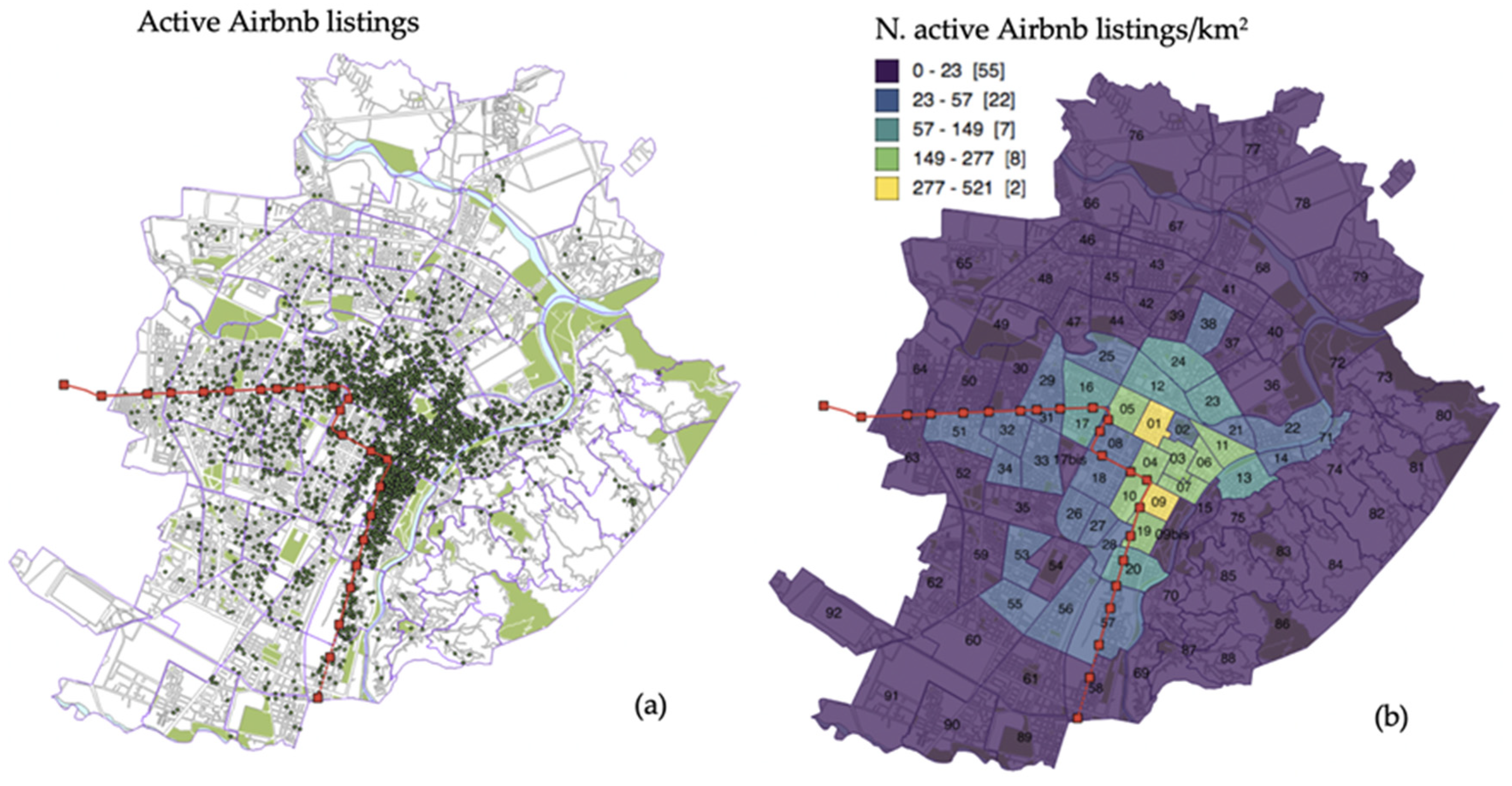
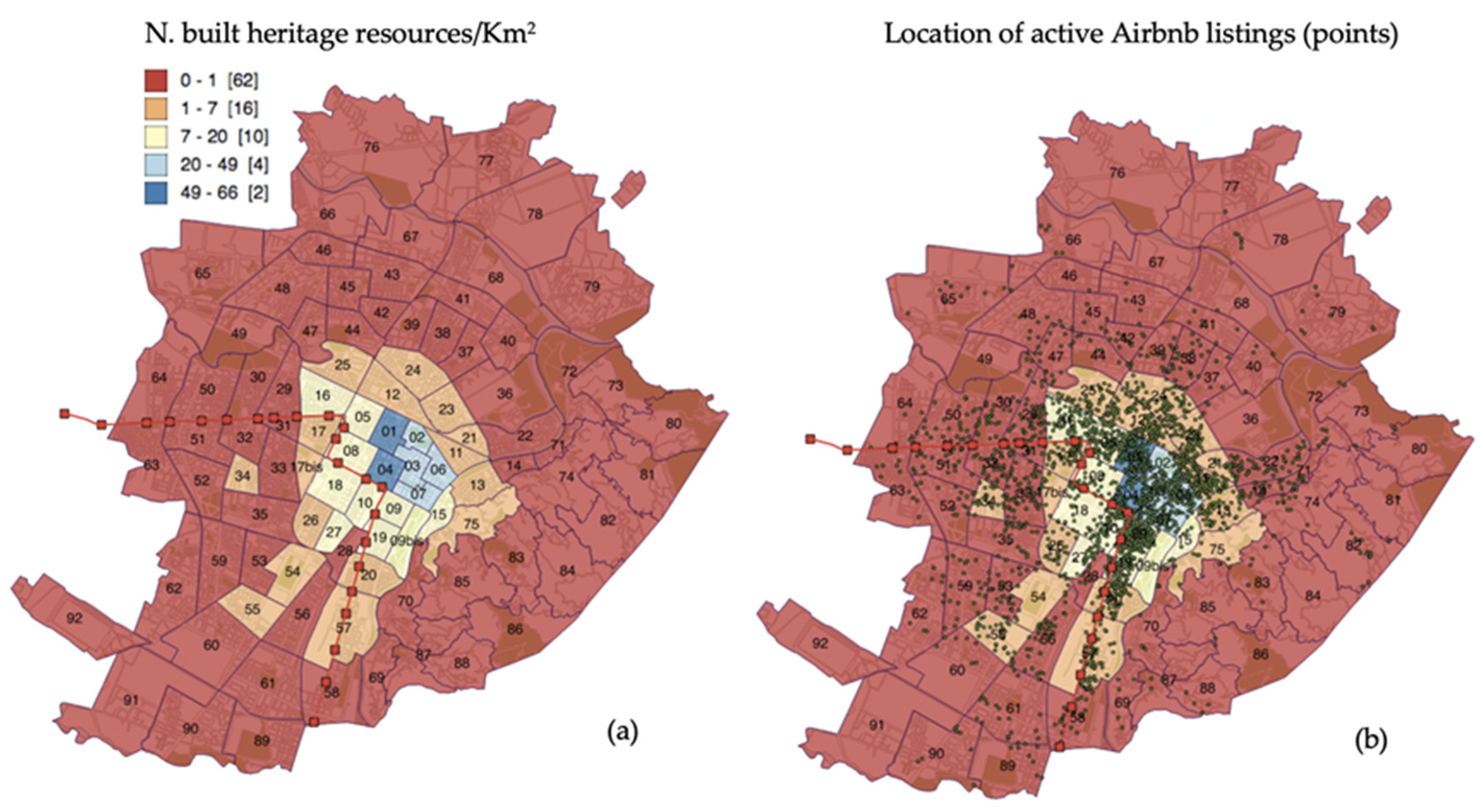


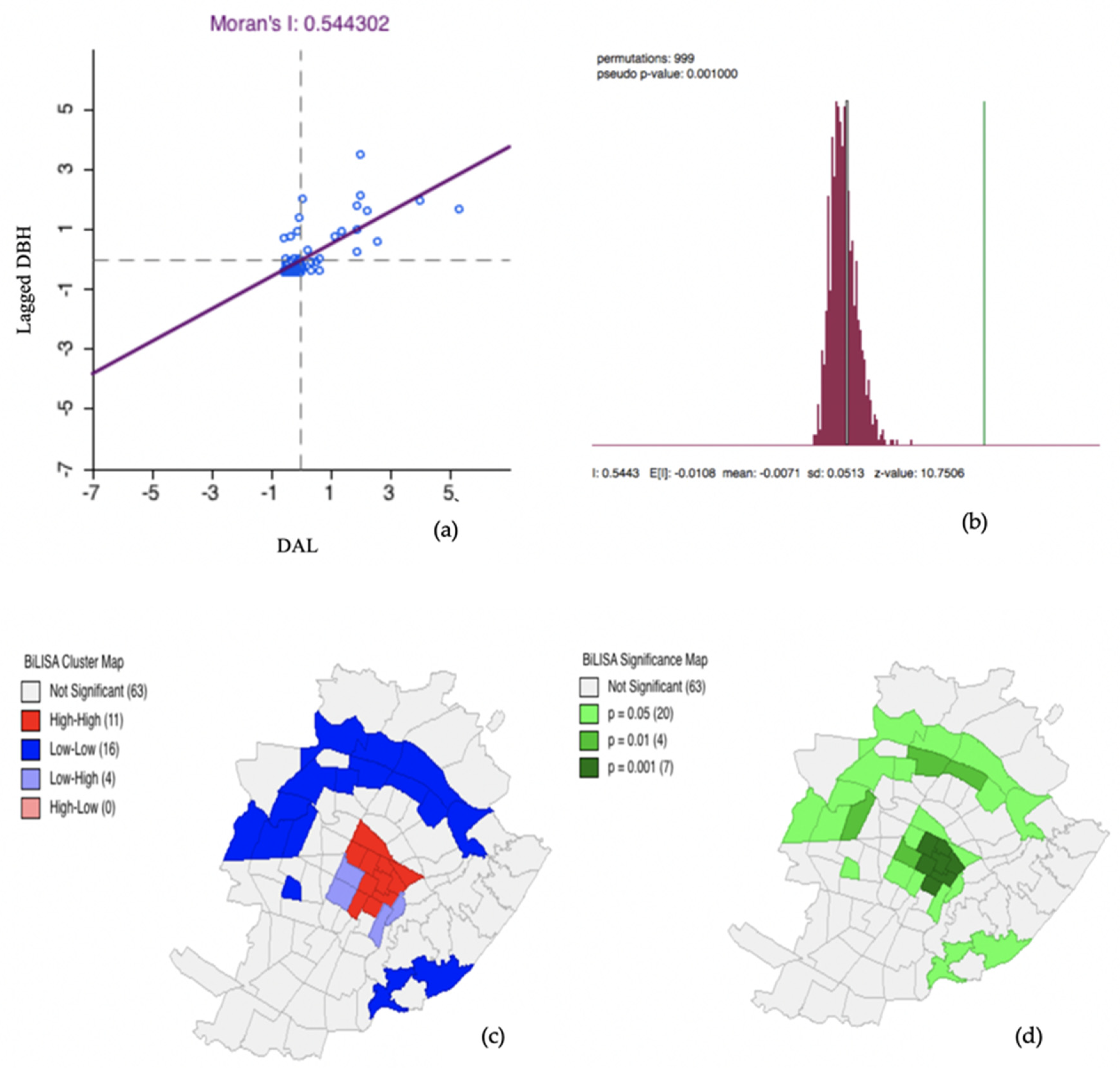
| Variable | Spatially Lagged Variable | Definition | Data Source | Bivariate Moran’s I | Pseudo p-Value (999 Permutations Test) |
|---|---|---|---|---|---|
| DAL | DBH | Number of built heritage resources/km2 | PDC | 0.544 | 0.001 *** |
| DM | Number of museums/km2 | GMT | 0.403 | 0.001 *** | |
| DCA | Number of commercial activities/km2 | GMT | 0.472 | 0.001 *** | |
| DFBA | Number of food and beverage businesses/km2 | GMT | 0.453 | 0.001 *** | |
| PD | Number of inhabitants/km2 | ISTAT | 0.132 | 0.003 ** | |
| IFR | Number of foreigner residents/residents, multiplied for 1000 | ISTAT | 0.044 | 0.203 | |
| VI | Synthetic index that describes the degree of social and economic vulnerability | ISTAT | −0.118 | 0.001 *** | |
| CCOI | Number of people working in the creative, cultural, sport, and entertainment industries/number of residents, in percentage | ISTAT | 0.263 | 0.001 *** | |
| OPRE | Average offer real estate prices, expressed in euros/m2 | ISTAT | 0.437 | 0.001 *** | |
| REEI | Number of residential buildings erected after 2005/number of residential buildings, in percentage | ISTAT | −0.044 | 0.097 | |
| BCI | Number of residential buildings showing a bad conservation state/number of residential buildings, in percentage | ISTAT | 0.020 | 0.269 | |
| EL | Number of people aged 25–64 with a high school degree or higher/number of residents of the same age segment, in percentage | ISTAT | 0.242 | 0.001 *** | |
| ER | Number of employed people aged ≥15 years/number of residents of the same age segment, in percentage | ISTAT | 0.313 | 0.001 *** |
© 2020 by the authors. Licensee MDPI, Basel, Switzerland. This article is an open access article distributed under the terms and conditions of the Creative Commons Attribution (CC BY) license (http://creativecommons.org/licenses/by/4.0/).
Share and Cite
Rubino, I.; Coscia, C.; Curto, R. Identifying Spatial Relationships between Built Heritage Resources and Short-Term Rentals before the Covid-19 Pandemic: Exploratory Perspectives on Sustainability Issues. Sustainability 2020, 12, 4533. https://doi.org/10.3390/su12114533
Rubino I, Coscia C, Curto R. Identifying Spatial Relationships between Built Heritage Resources and Short-Term Rentals before the Covid-19 Pandemic: Exploratory Perspectives on Sustainability Issues. Sustainability. 2020; 12(11):4533. https://doi.org/10.3390/su12114533
Chicago/Turabian StyleRubino, Irene, Cristina Coscia, and Rocco Curto. 2020. "Identifying Spatial Relationships between Built Heritage Resources and Short-Term Rentals before the Covid-19 Pandemic: Exploratory Perspectives on Sustainability Issues" Sustainability 12, no. 11: 4533. https://doi.org/10.3390/su12114533
APA StyleRubino, I., Coscia, C., & Curto, R. (2020). Identifying Spatial Relationships between Built Heritage Resources and Short-Term Rentals before the Covid-19 Pandemic: Exploratory Perspectives on Sustainability Issues. Sustainability, 12(11), 4533. https://doi.org/10.3390/su12114533






